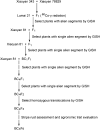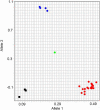Cytogenetic identification and molecular marker development for the novel stripe rust-resistant wheat- Thinopyrum intermedium translocation line WTT11
- PMID: 36304423
- PMCID: PMC9590478
- DOI: 10.1007/s42994-021-00060-3
Cytogenetic identification and molecular marker development for the novel stripe rust-resistant wheat- Thinopyrum intermedium translocation line WTT11
Abstract
Stripe rust, caused by Puccinia striiformis f. sp. tritici (Pst), is one of the most destructive diseases of wheat (Triticum aestivum L.) worldwide. Xiaoyan 78829, a partial amphidiploid developed by crossing common wheat with Thinopyrum intermedium, is immune to wheat stripe rust. To transfer the resistance gene of this excellent germplasm resource to wheat, the translocation line WTT11 was produced by pollen irradiation and assessed for immunity to stripe rust races CYR32, CYR33 and CYR34. A novel stripe rust-resistance locus derived from Th. intermedium was confirmed by linkage and diagnostic marker analyses. Molecular cytogenetic analyses revealed that WTT11 carries a TTh·2DL translocation. The breakpoint of 1B was located at 95.5 MB, and the alien segments were found to be homoeologous to wheat-group chromosomes 6 and 7 according to a wheat660K single-nucleotide polymorphism (SNP) array analysis. Ten previously developed PCR-based markers were confirmed to rapidly trace the alien segments of WTT11, and 20 kompetitive allele-specific PCR (KASP) markers were developed to enable genotyping of Th. intermedium and common wheat. Evaluation of agronomic traits in two consecutive crop seasons uncovered some favorable agronomic traits in WTT11, such as lower plant height and longer main panicles, that may be applicable to wheat improvement. As a novel genetic resource, the new resistance locus may be useful for wheat disease-resistance breeding.
Supplementary information: The online version contains supplementary material available at 10.1007/s42994-021-00060-3.
Keywords: CYR34; Cytogenetic analyses; KASP markers; PCR-based markers; Wheat660k SNP array; Wheat–Thinopyrum intermedium translocation line.
© The Author(s) 2021.
Conflict of interest statement
Conflict of interestThe authors declare that they have no conflict of interest.
Figures







Similar articles
-
Genetic mapping of a putative Thinopyrum intermedium-derived stripe rust resistance gene on wheat chromosome 1B.Theor Appl Genet. 2014 Apr;127(4):843-53. doi: 10.1007/s00122-014-2261-7. Epub 2014 Feb 2. Theor Appl Genet. 2014. PMID: 24487977
-
Identification and introgression of a novel leaf rust resistance gene from Thinopyrum intermedium chromosome 7Js into wheat.Theor Appl Genet. 2023 Oct 24;136(11):231. doi: 10.1007/s00122-023-04474-z. Theor Appl Genet. 2023. PMID: 37875643
-
Development and cytological characterization of wheat-Thinopyrum intermedium translocation lines with novel stripe rust resistance gene.Front Plant Sci. 2023 Feb 24;14:1135321. doi: 10.3389/fpls.2023.1135321. eCollection 2023. Front Plant Sci. 2023. PMID: 36909435 Free PMC article.
-
Cytogenetic and Genomic Characterization of a Novel Wheat-Tetraploid Thinopyrum elongatum 1BS⋅1EL Translocation Line with Stripe Rust Resistance.Plant Dis. 2024 Jul;108(7):2065-2072. doi: 10.1094/PDIS-12-23-2799-RE. Epub 2024 Jun 24. Plant Dis. 2024. PMID: 38381966
-
Molecular cytogenetics and development of St-chromosome-specific molecular markers of novel stripe rust resistant wheat-Thinopyrum intermedium and wheat-Thinopyrum ponticum substitution lines.BMC Plant Biol. 2022 Mar 12;22(1):111. doi: 10.1186/s12870-022-03496-x. BMC Plant Biol. 2022. PMID: 35279089 Free PMC article.
Cited by
-
Exploring the Agrobacterium-mediated transformation with CRISPR/Cas9 in cucumber (Cucumis sativus L.).Mol Biol Rep. 2022 Dec;49(12):11481-11490. doi: 10.1007/s11033-022-07558-z. Epub 2022 Sep 3. Mol Biol Rep. 2022. PMID: 36057005
-
Chromosomal mapping of a major genetic locus from Agropyron cristatum chromosome 6P that influences grain number and spikelet number in wheat.Theor Appl Genet. 2024 Mar 15;137(4):82. doi: 10.1007/s00122-024-04584-2. Theor Appl Genet. 2024. PMID: 38489037
-
The location and genome origin of alien chromatin in wheat founder parent Xiaoyan 6.Theor Appl Genet. 2025 Feb 1;138(2):41. doi: 10.1007/s00122-025-04826-x. Theor Appl Genet. 2025. PMID: 39891684
-
Development and Characterization of a Novel Wheat-Tetraploid Thinopyrum elongatum 6E (6D) Disomic Substitution Line with Stripe Rust Resistance at the Adult Stage.Plants (Basel). 2023 Jun 14;12(12):2311. doi: 10.3390/plants12122311. Plants (Basel). 2023. PMID: 37375936 Free PMC article.
-
Cytogenetic characterization of a novel wheat-rye 2R (2D) substitution line YT9 conferring powdery mildew resistance from the three-leaf stage and physical mapping of PmYT9.Theor Appl Genet. 2025 Jul 1;138(7):167. doi: 10.1007/s00122-025-04955-3. Theor Appl Genet. 2025. PMID: 40590982
References
-
- An DG, Ma PT, Zheng Q, Fu SL, Li LH, Han FP, Han GH, Wang J, Xu YF, Jin YL, Luo QL, Zhang XT. Development and molecular cytogenetic identification of a new wheat–rye 4R chromosome disomic addition line with resistances to powdery mildew, stripe rust and sharp eyespot. Theor Appl Genet. 2019;132:257–272. doi: 10.1007/s00122-018-3214-3. - DOI - PubMed
-
- Ardalani S, Mirzaghaderi G, Badakhshan H. A Robertsonian translocation from Thinopyrum bessarabicum into bread wheat confers high iron and zinc contents. Plant Breed. 2016;135:286–290. doi: 10.1111/pbr.12359. - DOI
-
- Baker L, Grewal S, Yang CY, Hubbart-Edwards S, Scholefield D, Ashling S, Burridge AJ, Przewieslik-Allen AM, Wilkinson PA, King IP, King J. Exploiting the genome of Thinopyrum elongatum to expand the gene pool of hexaploid wheat. Theor Appl Genet. 2020;133:2213–2226. doi: 10.1007/s00122-020-03591-3. - DOI - PMC - PubMed
-
- Bansal M, Kaur S, Dhaliwal HS, Bains NS, Bariana HS, Chhuneja P, Bansal UK. Mapping of Aegilops umbellulata-derived leaf rust and stripe loci in wheat. Plant Pathol. 2016;66:38–44. doi: 10.1111/ppa.12549. - DOI
LinkOut - more resources
Full Text Sources
Research Materials
Miscellaneous
